Ice displays in winter
Check out these eight frozen wonders around the watershed
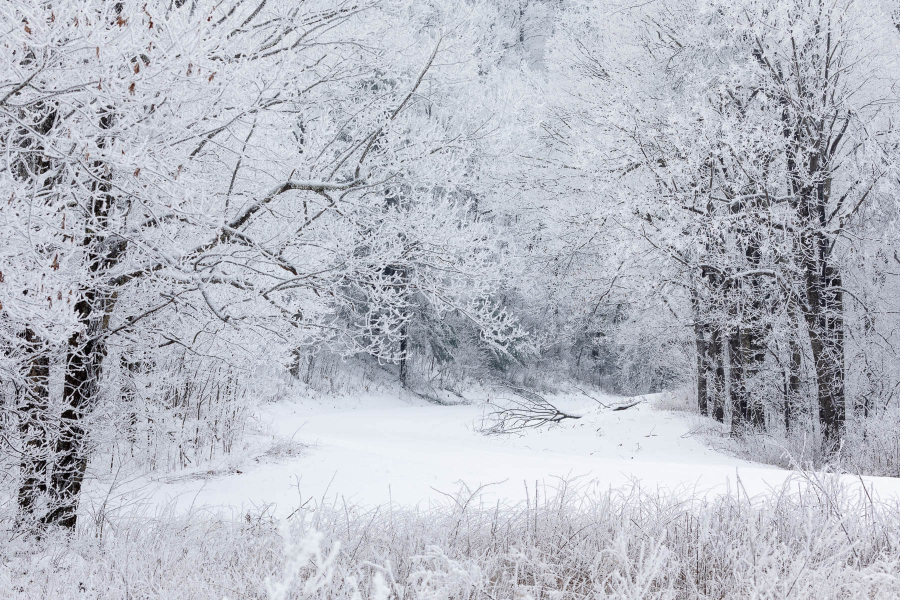
We often hear of how animals fare during the winter—bears hibernate, songbirds cuddle together and wood frogs freeze solid—but what do we know of the icy conditions the animals are weathering? They can be astounding, and found right in your own backyard. Check out some of the ways nature creates its winter conditions and ice formations and where you can go to find them.
Frost quakes and heaves
The proper name is cryoseism, but “frost quake” is a common term for these booming snaps in negative temperatures. Water expands when it freezes, whether it is in a river, your water bottle or underneath the ground. When the cold lingers in a wet area, the water that saturates the ground will freeze, making the ground much less flexible. If more water seeps in and freezes, that newly expanded ice puts incredible stress on the frozen and unmoving ground. If the stress gets to be too much, it will release that energy in a shatter that we hear as a cracking sound in the cold air.
Frost heaves are a lot like frost quakes, but here the underground expansion of ice happens close enough to the surface that pressure can be released simply by pushing the ground up. If you see a swell in the ground or under a roadway that looks like a Superman-strong gopher has tunneled beneath, you are likely looking at a frost heave.
Where can I see it? Frost heaves and quakes are not location specific. If it is very cold and the ground is permeable, you have a chance to see and hear these winter wonders.
Exploding trees
Another source of cold cracking sounds can be found in our forests when temperatures drop precipitously. While the sugars and other compounds in tree sap need a much lower temperature than water to freeze, it is not impossible. You won’t see a tree blast into smithereens from internal freezing, but the tension of the expanded, frozen sap can “pop” the tree, creating wounds that occasionally send a section of bark flying. Most trees recover just fine from this type of wound, but it does make them more susceptible to future freezes.
Where can I see it? Oak, ash, walnut, aspen, maple and many other species can potentially freeze if the temperature gets low enough. You can see this anywhere a tree grows in intensely cold weather—but maybe listen for this phenomenon rather than try to view it. Even on a small scale, exploding trees can present a danger for anyone standing nearby.
Window frost
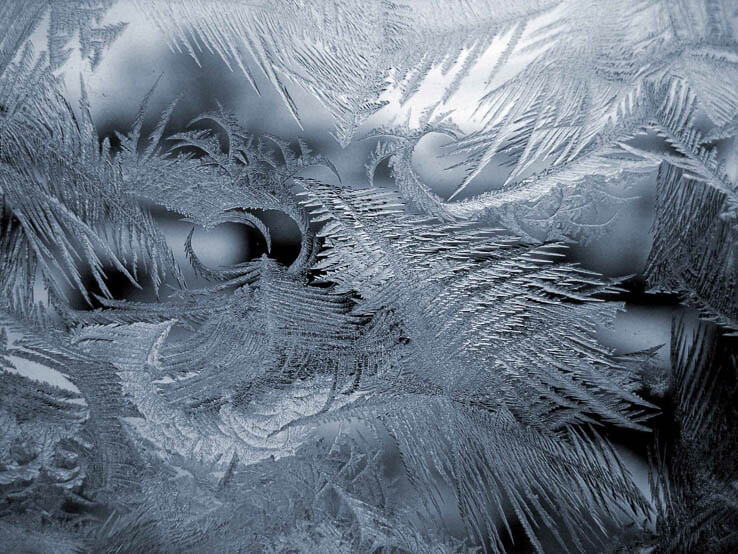
This formation appears on panes of glass when air outside is cold and air inside is moist and warm. Crystals form on the inside of the glass from condensing moist air, while whorls and spirals are created by the window surface. Imperfections in the glass, dust or streaks from a rag all influence the formations of the crystals.
Where can I see it? Most windows today are double-paned, but you will come across window frost in older single-paned buildings if there is a heat source within.
Rime ice
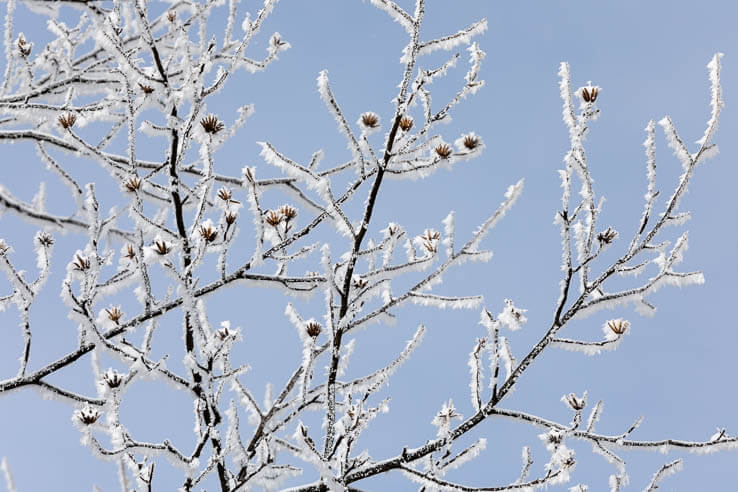 Rime frost covers a tulip tree (Liriodendron tulipifera), also known as tulip poplar, in the forest surrounding the Blue Ridge Parkway and the Appalachian Trail at Reeds Gap in George Washington and Jefferson National Forest in Nelson County, Va., on Jan. 14, 2019.(Photo by Will Parson/Chesapeake Bay Program)
Rime frost covers a tulip tree (Liriodendron tulipifera), also known as tulip poplar, in the forest surrounding the Blue Ridge Parkway and the Appalachian Trail at Reeds Gap in George Washington and Jefferson National Forest in Nelson County, Va., on Jan. 14, 2019.(Photo by Will Parson/Chesapeake Bay Program)
Rime ice, which can look spiky or soft and sugary, forms during a fog as water condenses. Supercooled water droplets (below the freezing point) are suspended in the air, and they freeze on contact to things they hit. Rime ice can be driven by wind, which makes it a dangerous formation on aircraft wings after flying through clouds. On the ground though and outside of danger, it makes the scene sparkle.
Where can I see it? Cool air sliding down from surrounding mountains can pool in valleys, with warm air sitting above it. This traps fog, which becomes supercooled on winter nights. A valley with surrounding elevated land is the ideal place to view large ice crystals, but anywhere the ground warms enough to create the necessary humidity or fog forms is a potential location for rime ice.
Hoar frost
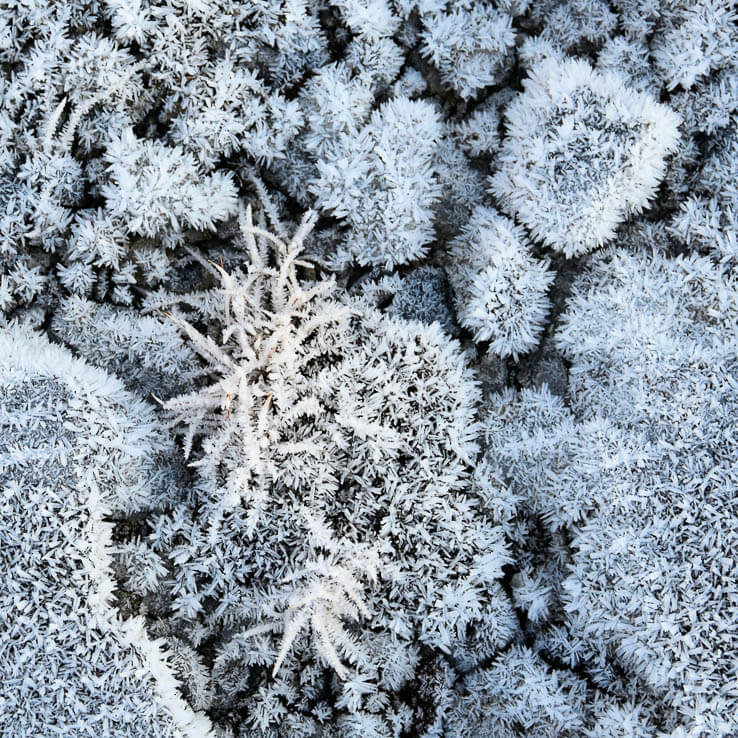 (Photo courtesy Atli Harðarson/Flickr CC BY-ND 2.0)
(Photo courtesy Atli Harðarson/Flickr CC BY-ND 2.0)
The origin of this term comes from words that mean “showing signs of old age”; apt because of the bearded look of these clear-morning ice crystals. While rime ice forms in humid conditions, hoar frost forms in the absence of fog on clear, calm nights. Water vapor, perhaps from a nearby body of water, condenses and grows into large formations. Hoar frost can be in flat or spiky crystals, and often makes the most beautiful formations on complex shapes like branches or blades of grass.
Where can I see it? Hoar frost will form on textured surfaces near still-liquid bodies of water, best found in morning before the sun can melt the formations or the wind destroys them. Get outside early on the next calm, cold morning and see where you can spot hoar frost!
Hair ice
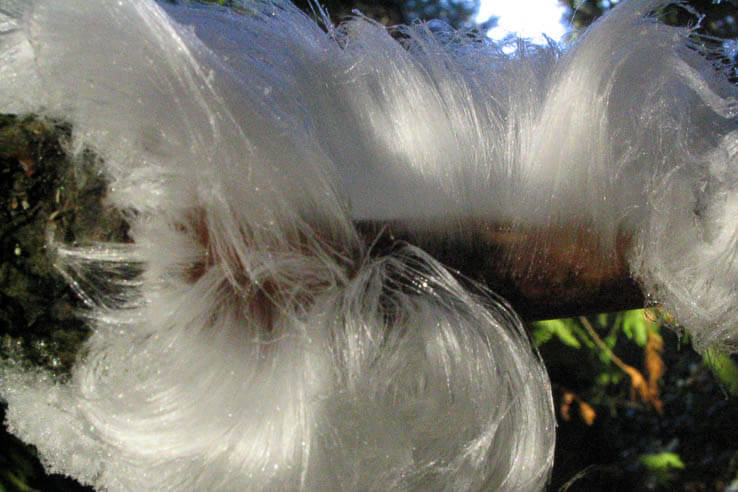
Hair ice, also known as wool ice or feather frost, forms when an interesting influencer is added to the mix: a wood-dwelling fungus.
Large pieces of dead wood can hold onto water for many hours, responding only slowly to changing weather conditions. Over time, water is drawn out of the tiny pores of the log and begins to freeze in the air. Usually this would result in a patch of solid ice, but fungus—a force which quietly influences most everything in the natural world from medicine to soil erosion—steps in to create magic.
The fungus Exidiopsis effusa likes to live in dead wood, using the wood’s internal cell structure to spread to the interior. The water that eventually becomes hair ice uses the same pathways, and therefore becomes mingled and contaminated with organic compounds from the fungus. Ice normally recrystallizes—meaning it will dissolve small crystals to form large, smooth ones—but this fungus, like most other living things, contains a biological antifreeze. When the ice exudes from the thinly separated cells of the wood and begins to crystallize, the compounds picked up from Exidiopsis effusa prevent recrystallization. Unable to form a sheet, the ice will stay in the form that it was in the wood and appear as delicate, hair-thin strands.
Where can I see it? The fungus is widespread but the conditions for hair ice are not easy to predict or manufacture, so this one may take some quiet searching in your local forest.
Frost flowers
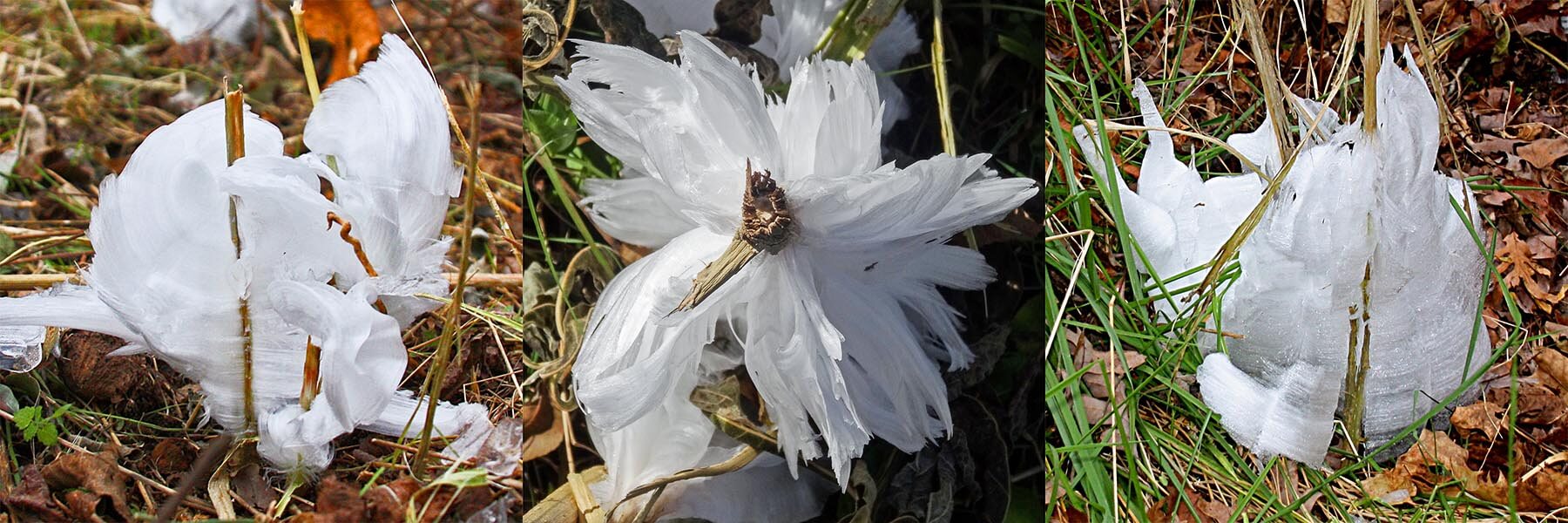 (Left and right photos courtesy Tanya Impeartrice/Flickr CC BY-ND 2.0, center photo courtesy Richard Nix/Flickr CC BY-NC 2.0)
(Left and right photos courtesy Tanya Impeartrice/Flickr CC BY-ND 2.0, center photo courtesy Richard Nix/Flickr CC BY-NC 2.0)
Similar to hair ice, you’ll find ethereal frost flowers blooming in the forests on cold, early mornings. In a frost flower, the ice forms when the air is below freezing but the ground temperature is warm enough for root systems to still be transporting nutrients to the plant. As the liquid travels up through the stem it begins to freeze, expanding and bursting through the stem. Unlike hair ice, however, there is no fungus to inhibit recrystallization. The ice spills from the thin slits and forms flowing sheets of icy ribbon candy.
Where can I see it? You have a good shot of seeing frost flowers right after the first hard frost of the year, but grab a cup of coffee and be out there in the early mornings. As soon as the sun hits these bright crystals blooms, they’ll melt and be lost.
Ice formations turn familiar forests into exotic places, but few see them occur as we curl up with blankets against the low temperatures. For those that brave the chill and opt for a winter stroll, an ephemeral world of icy crystal awaits. You don’t have to venture far to find it: check out parks, trails and public access sites to find opportunities to see winter’s artwork near you.

Comments
Fort Collins/ Colorado
What a wonderful article and even more amazing photos. I never saw frost flowers or ice hair when I in PA and MD in the 50s and 60s. Thank You
Thank you!
Your comment has been received. Before it can be published, the comment will be reviewed by our team to ensure it adheres with our rules of engagement.
Back to recent stories